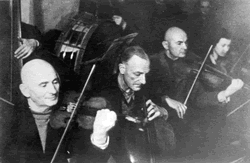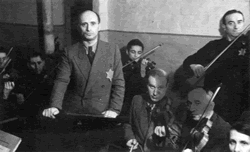Music in the Kovno Ghetto and Lithuania ( from the Yad Vashem site)
Kovno, Lithuania. The ghetto orchestra

Kovno, Lithuania. The ghetto orchestra
The songs of the Kovno ghetto presented here are from a repertoire of street and domestic songs (sung in the homes and courtyards) describing the difficulties of daily life in the ghetto. The songs are sung to prewar Yiddish folksong melodies. The authors and performers of the songs are unknown. Song no. 17 was published in Kaczerginski’s anthology, with the author’s name. A song from the Siualiai ghetto in Lithuania is also presented here, which tells the story of the children hidden and thus saved by non-Jewish families.
A Yidish Kind – A Jewish Child ( go to the Yad Vashem site to hear it)
Zingt un Tantst in Ridelekh – Sing and Dance in Circles
Vos Darf Ikh Hobn Mmer? – What Else Do I Need?
Geto Lebn – Ghetto Life
Baym Geto Toyerl – At the Ghetto’s Gate
Songs of the Kovno Ghetto
The Kovno Ghetto
Even before the Kovno ghetto was established in August 1941, Jews had been murdered by the Germans and the Lithuanians. When the ghetto was sealed off, there were 29,760 Jews, half of the 1939Jewish population of Kovno, on the eve of World War II. Within two-and-a-half months, 3,000 Jews had been murdered. On October 28 the “Great Action” was staged, in the course of which 9,000 Jews (half of them children) were taken to Kovno’s Ninth Fort and murdered. A prolonged period of relative calm followed, which lasted until March 1944. Of the 17,412 Jews remaining, most of the adults were put to forced labor, inside and outside the ghetto.
Within the ghetto, the Jews were ordered to elect a leader for the Jewish Council, the Judenrat, and they chose Dr. Elhanan Elkes, a popular doctor and a Zionist. The labor office of the Judenrat was the most important institution in the ghetto. At first, all men between the ages of 14 and 60 were recruited. Later, women were added. Men worked six or seven days a week; the women worked three days at first, and then five. By the spring of 1942, most ghetto inhabitants had been assigned specific jobs. Those without a permanent job were ordered to appear at the gate of the ghetto every morning to be assigned temporary labor. The foremen of the ghetto workshops were Jewish, while outside the ghetto they were Germans or Lithuanians. Those who worked outside the ghetto were escorted to work by armed Germans or Lithuanians. On returning to the ghetto, they received meager food rations as payment for their labor. The Nazis decided how much food they received. Starvation was rife, and smuggling of food and other products was essential for survival.
The ghetto was established in the poorest and most underdeveloped area in the town and had no sewage system. The living conditions and overcrowding in the ghetto led to the rapid spreading of epidemics, especially typhoid, which endangered all of the inhabitants. The sick were reluctant to ask for medical assistance or go to the ghetto hospital for fear of discovery by the Germans. This would result in them being forbidden to leave the ghetto for work in case they infected those around them. Thus the sick person would be doomed to death, for he would be denied his meager food rations, as well as the chance to smuggle food in. In response, the ghetto established a secret underground hospital.
The ghetto was a slave labor camp until its liquidation on 8 July 1944. When the Red Army approached Kovno, the German authorities began to transfer Jews to concentration camps inside Germany. Many went into hiding in underground bunkers they had prepared for that very purpose. The Germans blew up the bunkers, killing two thousand Jews. Only 90 survived in the bunkers, and merited to see the Red Army liberate Kovno on 1 August 1944.
Cultural Life in the Kovno Ghetto
Cultural activities in the Kovno ghetto were just another chapter, under their own historical circumstances, of the rich Jewish culture of Kovno. Kovno was a center of Jewish culture, both Hebrew and Yiddish, with an impressive school system from kindergarten to teacher-training colleges. Especially prominent was its religious culture, exemplified by the Slobodka Yeshiva. Two grade schools were opened in the ghetto. A few weeks after the mass murder of 27 October 1941, the children presented a special Hanukah program. At the end of February 1942, the Nazis confiscated all the books. Schooling continued, however, until August 1942, when it became completely forbidden by the Nazis. Nevertheless, small groups of children continued to study in various homes. Soon the Judenrat obtained permission to organize the training of young workers in different occupations. Within this framework, they also managed to teach elementary subjects and establish a choir and a drama circle – even a ballet group functioned under the auspices of the vocational school.
In the summer of 1942, the renowned musician Misha Hofmekler asked permission to form an orchestra. Dr. Elkes worried that an orchestra might be interpreted as an expression of joy, which had no place in the ghetto. Hofmekler explained that music satisfied an inner emotional need, and the Judenrat conceded. The Slobodka Yeshiva became the concert hall. When the first chords were struck in August 1942, both the performers and the audience cried, both from sorrow and from pride.
Religious observance continued, too. On August 1941, the Germans closed all synagogues, but observant Jews continued to pray and study the Torah.
The ghetto inhabitants composed songs that commented on the unfolding events with humor. The gate – the symbol of survival in the ghetto – appears in many songs. One, ”Fun di Arbet” (From Work), also known as “Baym Geto Toyerl” (At the Ghetto’s Gate), describes the survival in the ghetto that was dependent on smuggling, to the melody of the famous song by Mark Varshavski, “The Tiny Cheder.” The crowded ghetto and the starvation within are also discussed in these songs, similar to the street songs of the Lodz ghetto that were based on prewar Yiddish melodies. While they were recorded by Shmerke Kaczerginski and some were even published in his book, Lider fun di Getos un Lagern (Songs from the Ghettos and the Camps, 1948), they never found their place among the postwar songs of commemoration since they were mostly folksongs telling of daily life in the Kovno ghetto. These songs (unlike the Lodz ghetto songs) have now been researched for the very first time, and their presentation here restores them to the repertoire of Holocaust songs.
